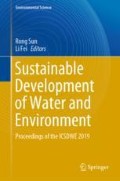Abstract
With the acceleration of China’s urbanization process, the expanding city scale has caused serious damage to the urban water system and natural water processes, which has led to the increasingly serious urban rainfall flood disasters. Developed countries have more experience in urban diseases, so the research on urban stormwater management and utilization has been Relatively well. For the study of the impact mechanism of green land demurrage, foreign countries have a relatively complete theoretical system and a large number of case practice tests. These rich practical experiences can be used as a reference for China. However, combined with China’s special national conditions and regional characteristics, we still need to carry out deeper and more local research. While domestic research on green land rain and flood detention is concentrated in water conservancy, plant protection and other disciplines, lacking different environmental characteristics for the city, In the perspective of macro-planning, the quantitative calculation of green space depletion efficiency capacity based on factors such as soil conditions, vegetation types, rainfall conditions.Urban green space is the main natural carrier of the rain stagnant. It is the main part of the construction of the sponge city. However, the currently attention of urban green space planning more focus on the ecological function such as oxygen release. It is relatively insufficient on the evaluation and planning studies on the efficacy of green area rainwater stagnation. By establishing the quantitative relationship between the characteristics of rainfall, runoff, soil, vegetation and other factors and the stagnant capacity of green space rainwater, the comprehensive impact mechanism is evaluated, and the artificial measures of rainwater control are combined to adjust the spatial pattern of urban green space , which is to improve the green storage efficiency. The use of indispensable content is also an inevitable development trend in the application of rainwater flood management in future urban green space depletion efficiency.
Access this chapter
Tax calculation will be finalised at checkout
Purchases are for personal use only
References
Coccolo S, Kaempf J, Mauree D, Scartezzini JL (2018) Cooling potential of greening in the urban environment, a step further towards practice. Sustain Cities Soc 38:543–559
Fletcher TD, Shuster W, Hunt WF et al (2015) SUDS, LID, BMPs, WSUD and more—the evolution and application of terminology surrounding urban drainage. Urban Water J 12(7):525–542
Gilroy KL, Mccuen RH (2009) Spatio-temporal effects of low impact development practices. J Hydrol 367(3–4):228–236
Jiao S, Zhang X, Xu Y (2017) A review of Chinese land suitability assessment from the rainfall-waterlogging perspective: evidence from the Su Yu Yuan area. J Cleaner Prod 144:100–106
Nicea KA, Couttsa AM, Tapper NJ (2018) Development of the VTUF-3D v1.0 urban micro-climate model to support assessment of urban vegetation influences on human thermal comfort. Urban Climate (Available online)
Song C, Porter A, Foster JS (2014) iTree: efficiently discovering high-coverage configurations using interaction trees. IEEE Trans Software Eng 40(3):251–265
Author information
Authors and Affiliations
Corresponding author
Editor information
Editors and Affiliations
Rights and permissions
Copyright information
© 2019 Springer Nature Switzerland AG
About this paper
Cite this paper
Wang, X., Cao, X., Shi, T. (2019). Application Status on Hydrological Detention Efficiency of Urban Green Space in China. In: Sun, R., Fei, L. (eds) Sustainable Development of Water and Environment. ICSDWE 2019. Environmental Science and Engineering(). Springer, Cham. https://doi.org/10.1007/978-3-030-16729-5_19
Download citation
DOI: https://doi.org/10.1007/978-3-030-16729-5_19
Published:
Publisher Name: Springer, Cham
Print ISBN: 978-3-030-16728-8
Online ISBN: 978-3-030-16729-5
eBook Packages: Earth and Environmental ScienceEarth and Environmental Science (R0)

